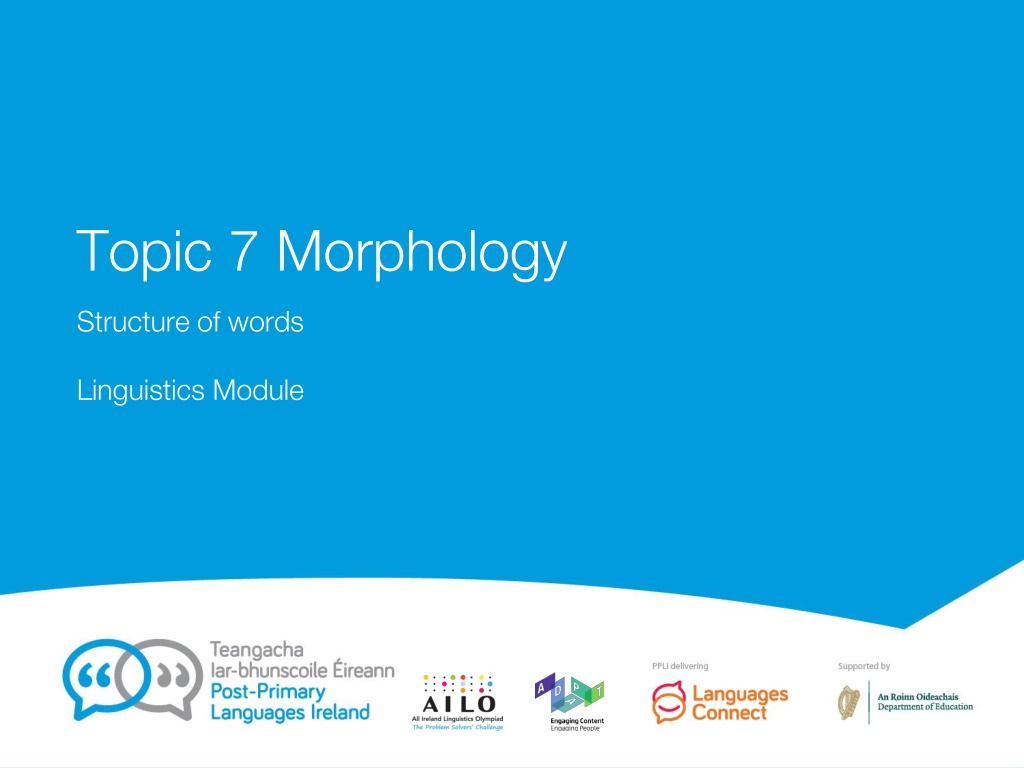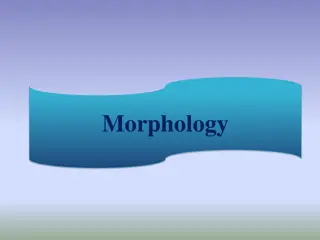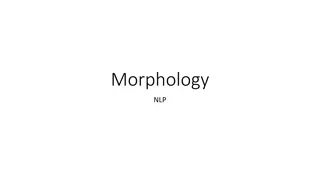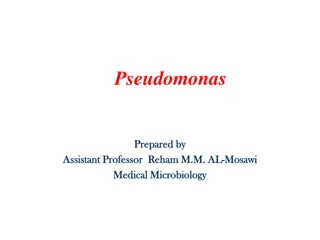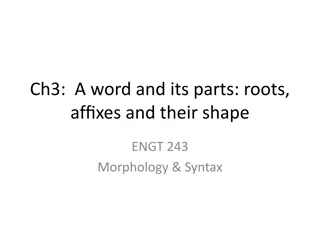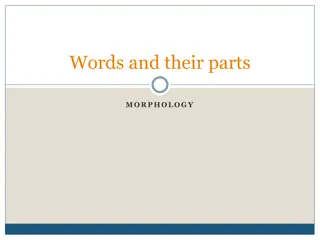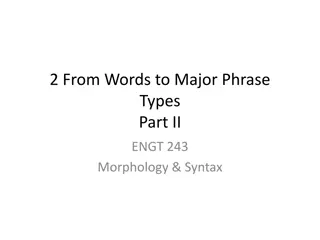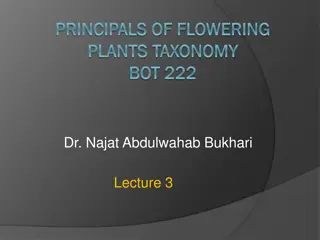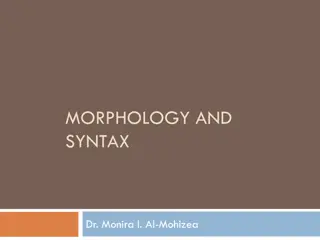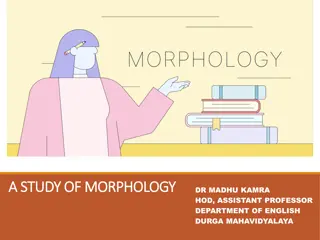Topic 7 Morphology
Delve into the realm of morphology in linguistics, exploring the internal structure of words, how words transform based on grammatical roles, and the processes of word formation through inflectional and derivational morphology. Uncover the various morphological processes and delve into the significance of morphemes as the fundamental units of meaning in language.
Download Presentation

Please find below an Image/Link to download the presentation.
The content on the website is provided AS IS for your information and personal use only. It may not be sold, licensed, or shared on other websites without obtaining consent from the author. Download presentation by click this link. If you encounter any issues during the download, it is possible that the publisher has removed the file from their server.
E N D
Presentation Transcript
Topic 7 Morphology Structure of words Linguistics Module
Overview of this Linguistics Module Topic 1 Introduction to areas of linguistics and problem-solving Topic 2 Historical Linguistics Topic 3 Phonetics Topic 4 Sociolinguistics Topic 5 Writing systems Topic 6 Language Acquisition Topic 7 Morphology Topic 7 Morphology Topic 8 Syntax Topic 9 Psycholinguistics / Neurolinguistics Topic 10 Machine Translation 2
What is morphology? Morphology is all about the internal structure of words. How words change according to their grammatical role (inflection) Or how new words are derived. We will look at How morphology works (morphological processes) What morphology is used for (morphological functions) 3
What do we mean by word formation? In many languages words can change their form depending on their grammatical role: Inflectional morphology Inflected forms are often thought of as the same word Or if we want to be precise we can talk of lexemes having different word forms (e.g. bring, brings, bringing, brought are all parts of the lexeme BRING) But we can also form new words related to existing words: Derivational morphology Usually thought of as different or new words We ll see examples of both soon. 4
Morphological processes The most usual way that morphology works in languages familiar to us is via endings (suffixes) but also prefixes attached to a root or stem But vowel changes are also quite common, In strong verbs , e.g. swim swam swum And in some irregular plurals, eg foot feet, man men And some are discontinuous e.g. in German the past participle is (often) the prefix ge + the suffix t as in geglaubt believed from glaub-en to believe Or in English break broken has a vowel change + an ending. And in some less familiar languages there are other interesting phenomena (eg reduplication) which you can research on your own if interested 5
Morphemes Morphemes are regarded as the minimal meaningful units in language Root morphemes obviously have a meaning But affixes also have some sort of meaning E.g. dogs is the root dog + the suffix s which means plural Morphemes can be either free (i.e. they can occur on their own) or bound (i.e. they cannot occur on their own) The suffix ing is always found attached to a root, usually a verb, and never on its own, so it is a bound morpheme Of course some morphemes can look like others that have a different meaning The suffix -hood meaning state of being something (as in childhood) looks like the word hood, but that s just a coincidence 6
Morphemes cont. The form of a morpheme can change depending on what other morphemes it combines with Example: swim + ing = swimming This is a general rule of English that in certain situations the last letter of the root is doubled You might say that swimm is the form of the morpheme swim when it occurs with ing The different forms of the same morpheme are called allomorphs Another example: hope + ing = hoping: this time the root has lost a letter! In Irish we have changes to the initial consonant of the root under certain circumstances. 7
Morphemes cont. Changes to the morpheme often depend on phonetics, and so the process is called morphophonemics Example 1: the prefix in- meaning negative can appear as im- if the root begins with a labial consonant (imperfect, immeasurable) Example 2: the plural suffix is usually s but after certain consonants it is es, reflecting the need to insert a vowel when you say the word (can you think of some examples?) 8
More on morphemes Root morphemes can change in ways we have already seen, but these are usually limited and predictable But it is quite common for bound inflectional morphemes to have a number of quite different allomorphs Example: the morpheme plural in English is often s or es, but can also involve a vowel change (foot-feet), an unusual ending (child- children) or no change at all (sheep-sheep) 9
Inflection vs derivation Inflectional morphology is the system of morphological changes (endings etc.) that relate to the grammar of the language Very widespread in familiar languages is the idea of agreement In English simple present tense if the subject is singular (but not I or you) the verb shows agreement (or concord ) by adding s or es. In French, German, Spanish etc. you ll be familiar with how adjectives reflect the number and gender of the noun they go with, usually with endings Other typical examples of inflectional morphology are grammatical markings such as Plural of nouns Tense of verbs Comparative and superlative of adjectives 10
Derivational morphology Derivational morphology on the other hand is about how new words are formed derived from existing words Mostly the same processes (prefixes, suffixes etc.) are used, but for a different purpose English has lots of ways of deriving related words of another part of speech: Forming an adjective from a noun (nation-national, danger-dangerous) Forming a noun from an adjective (happy-happiness notice the allomorph change) Forming a noun from a verb (meet-meeting, create-creation, teach- teacher) Forming a verb from a noun or adjective (factor-factorize, clear-clarify) Forming an adverb from an adjective (sad-sadly) 11
Derivational morphology cont. English also has ways to derive related words of the same part of speech Negatives or opposites (true-untrue) Female counterparts (actor-actress) Adding an element of meaning (sit-resit, pay-prepay-overpay) In English (though not necessarily in other languages) words can only take a single inflection But derivations can be piled up one on top of the other Example: nation-national-nationalist-nationalistic, happy-unhappy- unhappiness With a (single) inflectional morpheme at the end: nation+al+ist+s, factor+ise+ing 12
Conversion Derivational morphology is used to form related words of different parts of speech as we have seen But English is particularly tolerant of conversion , where words function as different parts of speech without any derivational morphology Nouns functioning as verbs and vice versa Nouns used as adjectives and vice versa So much so that it is often difficult to say for sure what part of speech a word basically is But even when the choice seems clear, words can be flexible, sometimes to the dislike of purists Example: Ireland hopes to medal in this event (i.e. win a medal) 13
Compounding Derivation so far has involved a single root with derivational affixes Most languages also allow a type of word formation where two (or more) roots are combined to form a compound Conventionally a compound may be closed (written as a single word eg doorway), hyphenated (eg long-term) or open (written as separate words eg ice cream) though preferences can vary, even depending on use (eg I bought an ice cream from an ice-cream seller) 14
Final word before we try some exercises Key issues: Inflection vs derivation Free vs bound morphemes Morphophonemic variation (phonetics affects morphology) Morphosyntax (Morphology depends on syntax/grammar) Languages vary widely in how much morphology they have English has relatively little inflectional morphology but derivation is very free Some languages (called isolating or analytic ) have almost no morphological complexity at all (eg Mandarin, Vietnamese) Others ( synthetic ) have very complex morphology, where affixes can be piled up on top of each other ( agglutinative languages eg Inuktitut, Turkish), or where single morphemes carry complex combinations of meanings ( fusional , eg Latin). 15
Task 7.1 Identifying Morphemes 16
Exercise 7.1 Identifying morphemes Give students the 7.1 Identifying Morphemes Worksheet The worksheet tasks you to break a number of words down to identify the individual morphemes, stating whether they are root (R), inflectional (I) or derivational (D). For each morpheme other than the root, give an approximate meaning or description of its function. 17
Task 7.2 Stages of Children s language production 18
Exercise 7.2 Stages of Childrens Language Production Give students the 7.2 Stages of Children s Language Production Using the table and worksheet in 7.2 Stages of Language Production, you should determine which grammatical morphemes the child has acquired in each of the example utterances and age. You will then do the exercise in reverse: stripping adult sentences of functional/grammatical elements. 19
Task 7.3 Maltese Morphophonemics puzzle 20
Exercise 7.3 Morphology Puzzle Students try the Maltese puzzle and solution 21
Thank you 22
